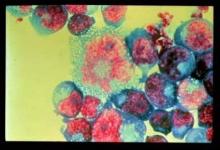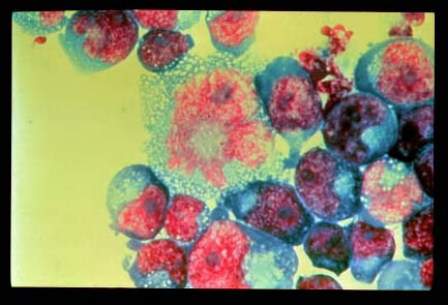User login
Interleukin-6 may have the strongest predictive power of the three biomarkers associated to date with adverse outcomes in patients infected with HIV, according to the results of a study published in the Journal of Infectious Diseases.
Elevated levels of the biomarkers intereukin-6 (IL-6), high-sensitivity C-reactive protein (hsCRP), and d-dimer were independently and strongly associated with a subsequent risk of death in the Strategies for Management of Anti-Retroviral Therapy trial, said first author Dr. Álvaro H. Borges of the department of infectious diseases at the center for health and infectious diseases research at the Rigshospitalet of the University of Copenhagen and colleagues.
They evaluated the relative value of IL-6, hsCRP, and d-dimer as predictors of different clinical endpoints in those infected with HIV. To accomplish this, Dr. Borges and colleagues used preserved blood samples from 4,304 patients from the control arms of two international HIV trials (SMART and ESPRIT). The investigators used the samples to measure the association of plasma levels of each biomarker with the risk of developing different clinical endpoints, including all-cause mortality, non-AIDS and nonviolent/accidental death, fatal and nonfatal progression to AIDS, fatal and nonfatal cardiovascular disease (myocardial infarction, stroke or coronary artery disease requiring a surgical procedure), and fatal and nonfatal non–AIDS-defining malignancies, excluding basal and squamous cell skin cancers (J Infect Dis. 2016 Apr 30. pii: jiw173).
IL-6 was superior to hsCRP in predicting cardiovascular and non–AIDS-defining malignancies and more strongly associated with these outcomes than d-dimer. As opposed to hsCRP and d-dimer, IL-6 showed heterogeneity as a predictor for different endpoints, suggesting that higher IL-6 level is a marker of both disease risk and disease severity.
Clinical endpoint–driven trials are needed to determine whether therapies designed to lower levels of the three assessed biomarkers can reduce morbidity and mortality in patients receiving treatment for HIV infection, the researchers said.
Funding was provided by the National Institutes of Health, the Research Council at Rigshospitalet, and the Danish National Research Foundation. Andrew N. Phillips disclosed ties to multiple industry sources. No other conflicts of interest were reported.
Interleukin-6 may have the strongest predictive power of the three biomarkers associated to date with adverse outcomes in patients infected with HIV, according to the results of a study published in the Journal of Infectious Diseases.
Elevated levels of the biomarkers intereukin-6 (IL-6), high-sensitivity C-reactive protein (hsCRP), and d-dimer were independently and strongly associated with a subsequent risk of death in the Strategies for Management of Anti-Retroviral Therapy trial, said first author Dr. Álvaro H. Borges of the department of infectious diseases at the center for health and infectious diseases research at the Rigshospitalet of the University of Copenhagen and colleagues.
They evaluated the relative value of IL-6, hsCRP, and d-dimer as predictors of different clinical endpoints in those infected with HIV. To accomplish this, Dr. Borges and colleagues used preserved blood samples from 4,304 patients from the control arms of two international HIV trials (SMART and ESPRIT). The investigators used the samples to measure the association of plasma levels of each biomarker with the risk of developing different clinical endpoints, including all-cause mortality, non-AIDS and nonviolent/accidental death, fatal and nonfatal progression to AIDS, fatal and nonfatal cardiovascular disease (myocardial infarction, stroke or coronary artery disease requiring a surgical procedure), and fatal and nonfatal non–AIDS-defining malignancies, excluding basal and squamous cell skin cancers (J Infect Dis. 2016 Apr 30. pii: jiw173).
IL-6 was superior to hsCRP in predicting cardiovascular and non–AIDS-defining malignancies and more strongly associated with these outcomes than d-dimer. As opposed to hsCRP and d-dimer, IL-6 showed heterogeneity as a predictor for different endpoints, suggesting that higher IL-6 level is a marker of both disease risk and disease severity.
Clinical endpoint–driven trials are needed to determine whether therapies designed to lower levels of the three assessed biomarkers can reduce morbidity and mortality in patients receiving treatment for HIV infection, the researchers said.
Funding was provided by the National Institutes of Health, the Research Council at Rigshospitalet, and the Danish National Research Foundation. Andrew N. Phillips disclosed ties to multiple industry sources. No other conflicts of interest were reported.
Interleukin-6 may have the strongest predictive power of the three biomarkers associated to date with adverse outcomes in patients infected with HIV, according to the results of a study published in the Journal of Infectious Diseases.
Elevated levels of the biomarkers intereukin-6 (IL-6), high-sensitivity C-reactive protein (hsCRP), and d-dimer were independently and strongly associated with a subsequent risk of death in the Strategies for Management of Anti-Retroviral Therapy trial, said first author Dr. Álvaro H. Borges of the department of infectious diseases at the center for health and infectious diseases research at the Rigshospitalet of the University of Copenhagen and colleagues.
They evaluated the relative value of IL-6, hsCRP, and d-dimer as predictors of different clinical endpoints in those infected with HIV. To accomplish this, Dr. Borges and colleagues used preserved blood samples from 4,304 patients from the control arms of two international HIV trials (SMART and ESPRIT). The investigators used the samples to measure the association of plasma levels of each biomarker with the risk of developing different clinical endpoints, including all-cause mortality, non-AIDS and nonviolent/accidental death, fatal and nonfatal progression to AIDS, fatal and nonfatal cardiovascular disease (myocardial infarction, stroke or coronary artery disease requiring a surgical procedure), and fatal and nonfatal non–AIDS-defining malignancies, excluding basal and squamous cell skin cancers (J Infect Dis. 2016 Apr 30. pii: jiw173).
IL-6 was superior to hsCRP in predicting cardiovascular and non–AIDS-defining malignancies and more strongly associated with these outcomes than d-dimer. As opposed to hsCRP and d-dimer, IL-6 showed heterogeneity as a predictor for different endpoints, suggesting that higher IL-6 level is a marker of both disease risk and disease severity.
Clinical endpoint–driven trials are needed to determine whether therapies designed to lower levels of the three assessed biomarkers can reduce morbidity and mortality in patients receiving treatment for HIV infection, the researchers said.
Funding was provided by the National Institutes of Health, the Research Council at Rigshospitalet, and the Danish National Research Foundation. Andrew N. Phillips disclosed ties to multiple industry sources. No other conflicts of interest were reported.
Key clinical point: Compared with high-sensitivity C-reactive protein and d-dimer levels, IL-6 is a stronger predictor of poor outcomes for those infected with HIV.
Major finding: Interleukin-6 was superior to high-sensitivity C-reactive protein in predicting cardiovascular and non–AIDS-defining malignancies and more strongly associated with these outcomes than was d-dimer.
Data sources: A cohort of 4,304 patients from the control arms of two international HIV trials.
Disclosures: The National Institutes of Health, the Research Council at Rigshospitalet, and the Danish National Research Foundation funded the study. Andrew N. Phillips disclosed ties to multiple industry sources. No other conflicts of interest were reported.

